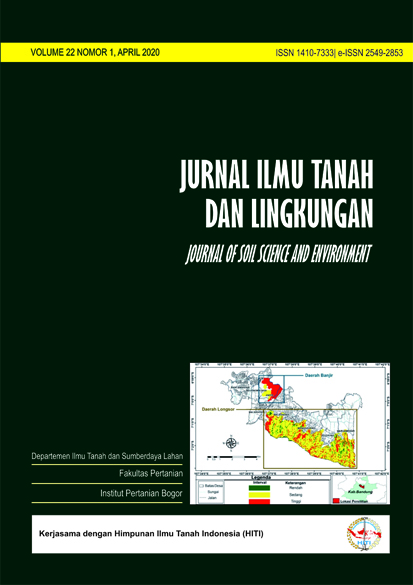Leaching of Organic Carbon in Micro Catchment Oil Palm Plantation Area PT Perkebunan Nusantara VI Jambi
Pencucian Karbon Organik pada Mikro DAS Lahan Perkebunan Kelapa Sawit PT Perkebunan Nusantara VI Jambi
Abstract
Land use change can affect the ecosystem and regional hydrology. It increase the erosion and surface runoff of the land, especially the land that is not in line with the principles of soil and water conservation. The high rainfall affects the leaching process of carbon and nutrients from agricultural land to the river body. The leaching process of organic carbon and nutrients in the river need to be researched. It predicts the concentration of organic carbon and nutrients in the river, and it can be the indicator in monitoring of the land degradation. This research applied field experiment which used survey method with explorative descriptive for purposive sampling. This study showed that the location of leaching the most organic carbon formed DOC, nitrate, Al3+, and Mn2+ is point C. The rainfall has less significant effect in increasing stream discharge (r = 0.58). Stream discharge and dissolved ion concentration in the outlet (DOC, NO3-, PO43-, Fe2+, and Al3+) has no positive correlation. DOC concentration in the river has positive correlation with Fe2+ (0.94) and Al3+ (0.96). The multi stepwise regression model produces DOC = 2.48 + 0.90 Al3+ + 3.17 Fe2+ with the quite high value of R2 Adj. (0.94). It showed that DOC has affected Al3+ and Fe2+ by 94%.
Downloads
References
Arifin, S., A. Hartono, K. Murtilaksono, S. Anwar, Sunarti dan Y. Kuzyakov. 2017. Hubungan karbon organik terlarut dengan sifat tanah pada toposekuen di taman nasional bukit duabelas. Jurnal Ilmu Tanah Lingkungan, 19(2): 51-59.
Bernal, S., A. Butturini and F. Sabater. 2005. Seasonal variations of dissolved nitrogen and DOC:DON ratios in an intermittent Mediterranean stream. Biogeochemistry, 75(2): 351–372.
Chantigny, M.H. 2003. Dissolved and water-extractable organic matter in soils: a review on the influence of land use and management practices. Geoderma, 113: 357– 380.
Corley, R.H.V. and P.B. Tinker. 2003. The Oil Palm 4th ed. Blackwell publishing, Oxford.
Comte, I., C. Francois, K.W. Joann, G. Olivier and P.C. Jean. 2012. Agricultural practices in oil palm plantations and their impact on hydrological changes, nutrient fluxes and water quality in indonesia: A review. Advances in Agronomy, 116(3): 72-114.
[Ditjenbun] Direktorat Jenderal Perkebunan. 2016. Statistik Perkebunan Indonesia Komoditas Kelapa Sawit 2015-2017. Kementerian Pertanian, Jakarta.
Do Nascimento, C.A.C., P.H. Pagliari, L.D.A. Faria and G.C. Vitti. 2018. Phosporus mobility and behaviour in soils treated with calsium, ammonium, and magnesium phosphate. Soil Science Society of American Journal, 82:622–631.
Hassett, J.J. dan W.L. Banwart. 1992. Soils and Their Environment. Prentice Hall, New Jersey. 95 p.
Hidayat. 2013. Run off, Discharge and Flood Occurance in a Poorly Gauged Tropical Basin, The Mahakam River, Kalimantan. Wageningen University, Wageningen.
Hinton, M.J, S.L. Schiff and M.C. English. 1997. The significance of storms for the concentration and export of dissolved organic karbon from two Precambrian Shield catchments. Biogeochemistry, 36(1): 67–88.
Mengel, K. and E.A. Kirkby. 1982. Principles of Plant Nutrition. International Potash Institute, Switzerland. Pp. 491-498.
Mulder, J. and M.S. Cresser. 1994. Biogeochemisthry of small catchment: a tool for environmental research. B. Moldan and J.V. Cerny (Eds.). John Willey & Sons Inc., New York.
Ng, S.K., H. von Uexkull and R. Hardter. 2003. Botanical Aspects of The Oil Palm Relevant to Crop Management. In Oil Palm: Management for Large and Sustainable Yields. Potash & Phosphate Institute/Potash Institute of Canada and International Potash Institute, Singapore. Pp. 13–26.
Noor, D. 2006. Geologi Lingkungan. Graha Ilmu. Yogyakarta. IUEU-University Press, Jakarta Barat.
Pardon, L., B. Cecile, N.N. Paul, D. Bernard, O. Jean, M. Raphael, P.C. Jean and G. Benoit. 2016. Key unknowns in nitrogen budget for oil palm plantations. A review. Agron. Sustain. Dev., 36: 1-21.
Putra, G.S., A. Hartono, S. Anwar dan K. Murtilaksono. 2019. Hubungan kation-anion dalam pergerakan dan pencucian hara pada tanah typic hapludult di taman nasional bukit duabelas. Journal of Natural Resources and Environmental Management, 9(4): 960-969.
Russel, E.W. 1978. Soil Conditions and Plant Growth. William Clowes and Sons, London. Pp. 40-41.
Shen, J., L. Yuan, J. Zhang, H. Li, Z. Bai, X. Chen, W. Zhang and F. Zhang. 2011. Phosporus dynamics: from soil to plant. Plant Physiology, 156: 997-1005.
Tan, K.H. 2011. Principle of Soil Chemisthry. Fourth edition. CRC press, Georgia.
Zech, W. and G. Guggenberger. 1997. Organik matter dynamics in forest soils of temperate and tropical ecosystems. In: A. Piccolo (Ed.). Humic Substances in Terrestrial Ecosystems. Elsevier, Amsterdam. Pp. 101-170.
Department of Soil Science and Land Resources Departemen Ilmu Tanah dan Sumberdaya Lahan, Faculty of Agriculture Fakultas Pertanian, IPB University



















